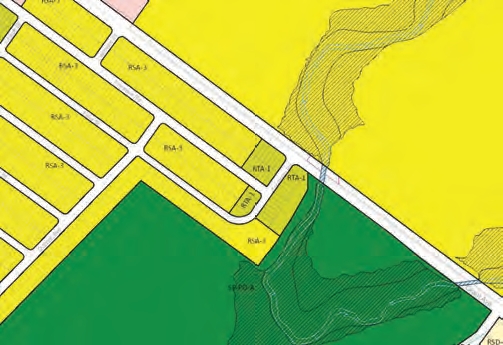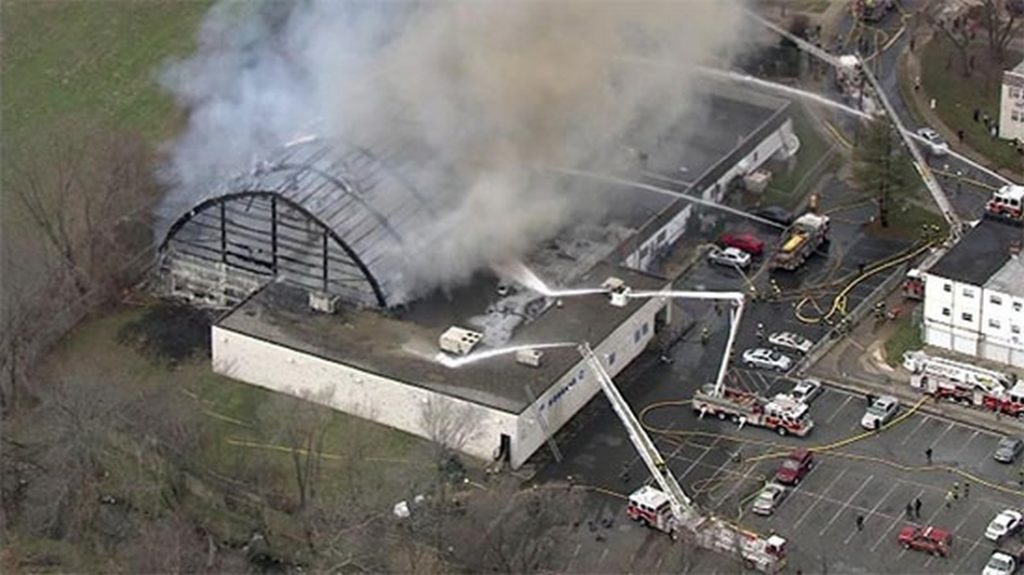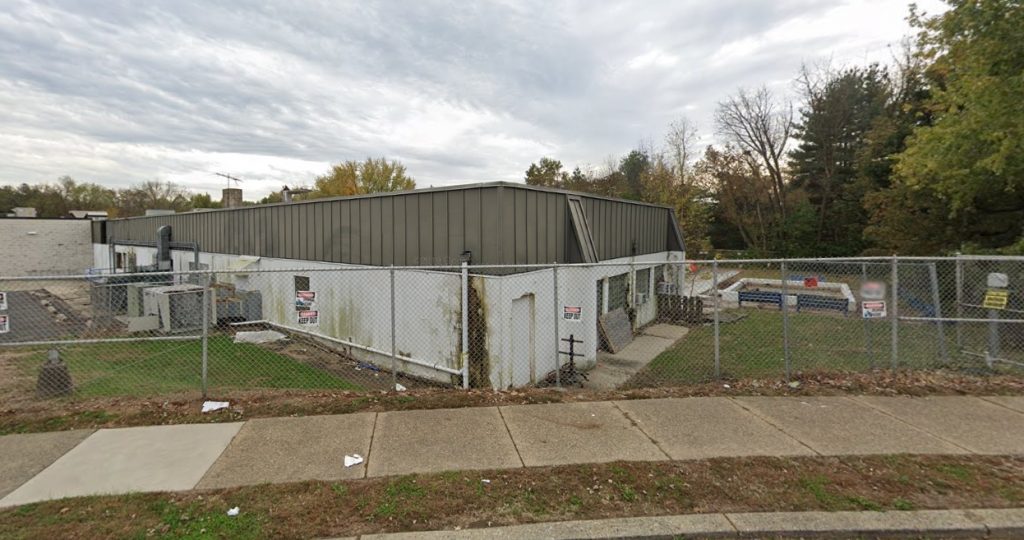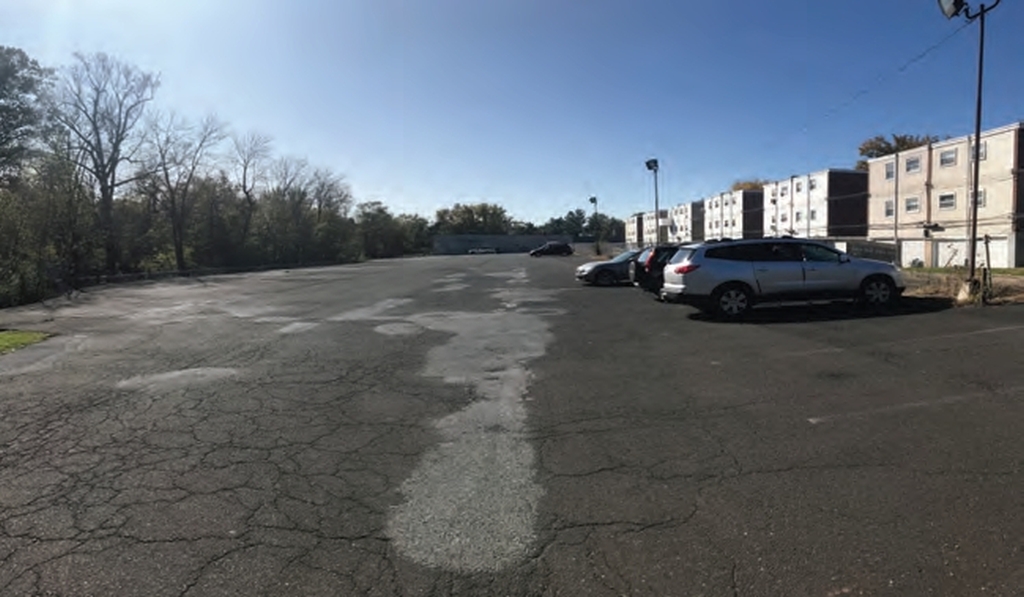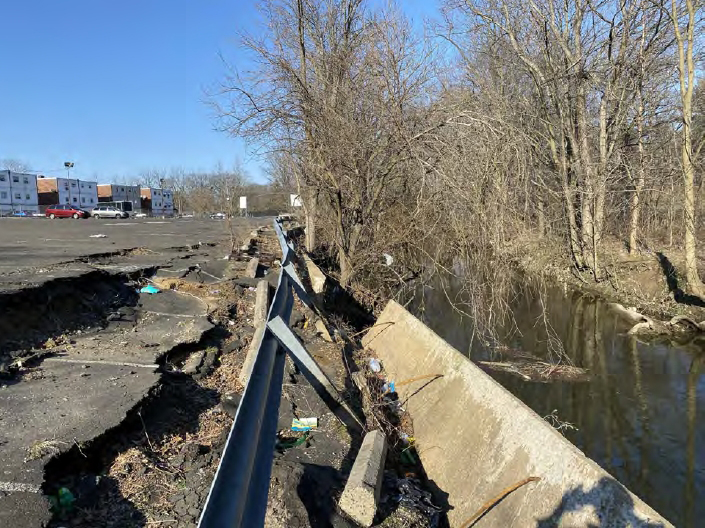Philly YIMBY recently shared new site plans and renderings for Torresdale Manor Residences, a townhouse development planned at 3600 Grant Avenue in the Academy Gardens section of Torresdale, Northeast Philadelphia. Designed by Abitare Design Studio, the project will rise at the former site of a once-renown aquatic center, shuttered after a devastating 2017 fire. The proposal includes 30 single-family residences, a new roadway, and a nature trail along the adjacent Byberry Creek. Today we take an in-depth look at the development and the insight it offers into incorporation of positive, pedestrian-friendly elements into otherwise car-oriented master plans.
Torresdale Manor Residences at 3600 Grant Avenue. Credit: Abitare Design Studio via the Civic Design Review
Torresdale Manor Residences at 3600 Grant Avenue. Credit: Abitare Design Studio via the Civic Design Review
Torresdale Manor Residences at 3600 Grant Avenue. Credit: Abitare Design Studio via the Civic Design Review
The Neighborhood
Torresdale is a predominantly residential neighborhood in Far Northwest Philadelphia, located to the southeast of the Northeast Philadelphia Airport, stretching from the Delaware River to the southeast to Pennypack Park to the northwest. Torresdale Manor Residences are planned at the eastern fringe of Academy Gardens (apparently misspelled as Academy Garden on Google Maps, a service notorious for mishandling neighborhood names and for occasional typos), a somewhat discrete district that comprises the western third of Torresdale.
3600 Grant Avenue. Credit: Google
Academy Gardens is bordered by Grant Avenue to the north, Pennypack Park to the west, the John F. Byrne Golf Course to the east, and Holme Avenue to the south. The latter is named after Thomas Holme, Pennsylvania’s first Surveyor General, who, in the 17th century, laid out the original Philadelphia city plan, which today comprises the extent of Center City. The land that makes up Academy Gardens was originally part of Holme’s farmland holdings.
Map of the Original City of Philadelphia in 1682 by Thomas Holme
After World War II, during a period of rapid suburbanization, the neighborhood was built out with single-family, predominantly semi-detached homes, generally settled by veterans. Many were “starter homes” that were left largely unfinished to lower costs. While they were effective as a form of affordable housing, their often nondescript exteriors have contributed to the neighborhood’s prosaic streetscape. However, like many early, inner-ring suburbs, the lots are generally smaller and the blocks are built out more densely than many of the city’s suburbs, making them more conducive to traditional urban interaction.
Primrose Avenue, half a block north of 3600 Grant Avenue. Looking northwest. Credit: Google
Fordham Road, with 3600 Grant Avenue in the background. Looking southwest. November 2019. Credit: Google
Academy Gardens is notable for its sinuous roads and exceptionally long city blocks, many of which surpass 1,000 feet in length, with some extending nearly 1,700 feet in length (ironically, the layout is the antithesis to Holme’s rectilinear grid for the original city plan). These blocks, unusually long even for suburbanized Northeast Philadelphia, and a near-total absence of retail and other non-residential uses, poises the neighborhood as particularly inconvenient for pedestrian activity. As a partial saving grace, pervasive sidewalks, two bus lines (route 19 on Outlook Avenue and route 20 on Academy Road), and an ALDI supermarket on Grand Avenue and Academy Road offer certain pedestrian-accessible amenities.
3600 Grant Avenue. Looking north. Credit: Google
Despite being flanked by two extensive green spaces, neither offer any recreational access to the public. The section of Pennypack Park to the west is a publicly inaccessible woodland along the Wooden Bridge Run creek. The golf course flanks the neighborhood to the east. As such, the nature trail, however minor, will still offer welcome green relief to the area, at least to the residents on the adjacent block.
The Site
Torresdale Manor Residences will span an L-shaped, roughly 2.5-acre site hemmed in between a back alley behind townhouses on Fordham Road to the northwest and the golf course to the southeast and the southwest. The new semi-private access road will start at the west end of the site, at a bend of the road where Fitler Street turns into Fordham Road, and will traverse the site until it meets Grant Avenue to the east.
3600 Grant Avenue. Credit: Google
3600 Grant Avenue via the Civic Design Review
Torresdale Manor Residences at 3600 Grant Avenue. Credit: Abitare Design Studio via the Civic Design Review
As of now, the entire site still bears a singular Grant Avenue address and the future access road remains unnamed, so it is unclear how the address system will work within the development.
Tentative house numbering at Torresdale Manor Residences at 3600 Grant Avenue. Credit: Abitare Design Studio via the Civic Design Review
The Aquatic Center
The site was previously home to the Aquatic & Fitness Center, part of the local AFC Fitness chain that presently maintains two facilities in northern Philadelphia suburbs, one in Bala Cynwyd and another in Feasterville. The Torresdale location consisted of an indoor facility by the junction of Fitler Street and Fordham Road.
The centerpiece consisted of a large swimming pool covered by a massive, roughly 40-foot-tall barrel roof that rose prominently above adjacent two-story residential houses. Until its demise in 2017, the pool remained the largest year-round swimming facility in the Philadelphia area. A large outdoor parking lot with space for approximately 250 cars spanned the rest of the site.
3600 Grant Avenue. Looking south. May 2012. Credit: Google
AFC Fitness Center at 3600 Grant Avenue in Torresdale. Credit: AFC Fitness
Torresdale Manor Residences at 3600 Grant Avenue. Credit: Abitare Design Studio via the Civic Design Review
The aquatic center had an illustrious history. It opened in the spring of 1963 as the home of the Philadelphia Aquatic Club, built by contractor Tom Williams. Massive wooden arches supported a frame clad in translucent polyvinyl chloride plastic, which, according to an article in the 1964 issue of the Swimming World magazine, created a “dome-like roof which allows rays of light to penetrate and dip and dance on the smooth waters.”
The Philadelphia Aquatic Club. Credit: Swimming World Magazine
A 2017 article from the same magazine claims that, upon opening, “the pool’s bulkheads, gutter system, portable roof and even locker rooms were considered state-of-the-art.” The pool hosted a great number of major competitions through the 1970s and 1980s. By the late 2010s, Bruce Wigo, the club’s manager and head men’s coach at the pool from 1972 to 1973, eventually rose to the role of the President/CEO of the International Swimming Hall of Fame, and in 2020 was inducted into the USA Water Polo Hall of Fame.
The Philadelphia Aquatic Club. Credit: Swimming World Magazine
The 1965 film, titled Swimming the American Way, described the facility in glowing terms as a premier sports center with an Olympic-sized swimming pool (measuring around 165 by 60 feet, a figure that falls only slightly short of modern Olympic standards) and a 33-foot diving tower. In an understated remark the narrator mentions that there is an inch of insulation between the colored translucent panels. Little did he know that said insulation would be the catalyst for the pool’s demise half a century later.
The facility was destroyed on the fateful morning of March 6, 2017, when a four-alarm blaze reduced the imposing structure to a blackened ruin. According to a contractor, a construction team was performing heat welding work at the roof when insulation caught on fire, spreading within minutes through the facility.
Astoundingly, the work was being performed while the facility was fully operational, with around 100 patrons inside the building at the start of the incident, including a group of senior citizens undergoing aquatic therapy. Witnesses recalled that “chaos erupted” as everyone tried to escape. Many were still wearing just their swimming gear as they hurried outdoors, where temperature was in the low 40s Fahrenheit.
AFC Fitness Center fire. Credit: Channel 6 ABC Action News
AFC Fitness Center fire. Credit: Channel 6 ABC Action News
Despite the rapid spread of the fire, all occupants were able to make it out of the facility in time, with only two persons receiving treatment for smoke inhalation. At the time, the AFC Fitness President described the outcome as “extremely fortunate.”
The fire was extinguished by around noon with no apparent damage to the surrounding buildings, though falling embers scorched several adjacent residential lawns. Fortunately, the wind appeared to be blowing in the northeastern direction, sending the majority of the smoke and embers over the parking lot rather than across the adjacent semi-wooded landscape around the creek and at the golf course or over the residential nrighborhood.
AFC Fitness Center fire. Credit: the Philadelphia Fire Department
AFC Fitness Center fire. Credit: the Philadelphia Fire Department
AFC Fitness Center fire. Credit: iRadioPhilly
On the day of the incident, the fitness chain owner expressed intent to rebuild the facility. However, no such plans came to fruition. In January 2020, AFC Fitness announced that it no longer plans to rebuild the complex, stating that the company worked with architects and planners to come up with a reconstruction plan yet were unable to come to terms with an insurance company.
The charred remains of the hangar-like dome were dismantled by 2018, and a low-rise wing of the shutterd facility remained standing at the site until at least 2019.
3600 Grant Avenue. Looking south. November 2019. Credit: Google
Current site conditions at 3600 Grant Avenue via the Civic Design Review
Curiously, the AFC Fitness banners, which faced Grant Avenue and welcomed visitors into the long-abandoned parking lot, remained present for an equally long time.
Current site conditions at 3600 Grant Avenue via the Civic Design Review
The diving tower still looms over the pool, which, according to recent satellite photos, is collecting water and has become a breeding ground for algae. However, photos in the Civic Design review show the pool in a cleaner, though still derelict, condition.
3600 Grant Avenue. Credit: Google
Current site conditions at 3600 Grant Avenue via the Civic Design Review
Current site conditions at 3600 Grant Avenue via the Civic Design Review
The parking lot has severely deteriorated in the meantime. As shown in photographs provided within the Civic Design Review submission, the concrete retaining wall at the southeast edge of the lot has begun to bulge and collapse into the Byberry Creek, which flows through the adjacent golf course, leading parts of the parking lot to severely erode and partially cave in.
Current site conditions at 3600 Grant Avenue via the Civic Design Review
Current site conditions at 3600 Grant Avenue via the Civic Design Review
Current site conditions at 3600 Grant Avenue via the Civic Design Review
Current site conditions at 3600 Grant Avenue via the Civic Design Review
Current site conditions at 3600 Grant Avenue via the Civic Design Review
Current site conditions at 3600 Grant Avenue via the Civic Design Review
Proposed Site Plan
The planners wisely decided to capitalize on the site’s exposure to the creek, which has a roughly 650-foot-long exposure to the development. Houses will line both sides of the shorter western segment of the L-shaped roadway. By contrast, the longer eastern segment will only feature residences on the interior side, while a roughly 400-foot-long nature trail will run between the road and the creek.
Torresdale Manor Residences at 3600 Grant Avenue. Credit: Abitare Design Studio via the Civic Design Review
Torresdale Manor Residences at 3600 Grant Avenue. Credit: Abitare Design Studio via the Civic Design Review
The layout will provide a recreational opportunity for local residents while also allowing for views of the creek and the verdant golf course from effectively every townhouse within the development. To prevent erosion issues that destroyed portions of the parking lot, the plan calls for reinforcing the steep creek bank with a roughly ten-foot-high Greenloxx Filterexx Livingwall System, which uses rolled “sock anchors” to maintain steep earthen slopes. The rollers will rest on compacted and reinforced soil and will allow for vegetation to grow at the top, creating a natural appearance.
The walking trail will be paved in a porous material, which will further reduce rainwater runoff. The slope will feature native plantings and grasses. A wooden split rail fence will separate the walkway from the green slope, adding a rustic touch to the trail. The path will be elevated over ten feet above the creek, well above the stream bed’s high water mark and flood line.
Torresdale Manor Residences at 3600 Grant Avenue. Credit: Abitare Design Studio via the Civic Design Review
Torresdale Manor Residences at 3600 Grant Avenue. Credit: Abitare Design Studio via the Civic Design Review
Greenloxx Filterexx Livingwall systems via the Civic Design Review
The project will provide an abundance of new plantings. The proposed vegetation list includes 33 large trees (14 sweetgum, eight honey locust, six white pine, and five river birch), 37 small trees (14 paperback maple, 14 red bud, and nine service berry), and 121 shrubs (44 blue star, 32 Virginia sweetspire, 25 arrowood viburnum, 14 sweet pepperbrush, and six red osier dogwood), as well as perennials (purple coneflower) and ornamental grasses (little bluestem and red switch grass).
The site will include parallel parking along the trail and two minor parking bays with perpendicular parking spots, which would allow visitors to park by the trail. Pedestrian access to the trail will be facilitated with two mid-block crossings equipped with stop signs.
Torresdale Manor Residences at 3600 Grant Avenue. Credit: Abitare Design Studio via the Civic Design Review
The previous version of the site plan called for three smaller perpendicular parking bays, a longer yet straighter nature trail, and a small pavilion in the park. The updated plan regrouped parking bays in a more efficient manner, slightly expanded the width of residential lots, streamlined the roadway alignment, fixed an irregular L-shaped private lot (unit 19), and redesigned the walking trail in a slightly winding, more organic manner. The only downsides is the slight decrease in the total amount of shared green area and the elimination of the park pavilion.
Original site plan for Torresdale Manor Residences at 3600 Grant Avenue. Credit: Abitare Design Studio via the Civic Design Review
Updates site plan for Torresdale Manor Residences at 3600 Grant Avenue. Credit: Abitare Design Studio via the Civic Design Review
The Townhouses
The designs for individual townhouses are rather understated yet attractive, featuring gabled roofs and room-sized dormers. The homes are a vast improvement over the dull, boxy, barrack-like residences that predominate in the area. The proposed buildings’ exterior articulation, twinned pairing, and relative proximity to the street will create a quaint composition with a certain traditional “small town” feel that is lacking in many of the surrounding housing tracts, where large and featureless front lawns, long driveways, and bland architecture create much less aesthetically pleasing streetscapes.
Each house will rise three stories and 33 to 34 feet high. One townhouse variant will measure 20 feet wide and 37 feet long, will occupy an 843-square-foot footprint, and include 1,480 square feet of gross floor area. The second version will be slightly larger, measuring 20 feet wide and 42 feet long, spanning a 945-square-foot footprint, and featuring 1,680 square feet of floor area. Each building will include a fully finished basement. The second variant will feature 15-foot-wide and 12-foot-deep rear decks overlooking spacious backyards.
Torresdale Manor Residences at 3600 Grant Avenue. Credit: Abitare Design Studio via the Civic Design Review
The townhouses will be clad in horizontal dark gray vinyl siding at the front and rear, with light gray siding on the side walls. Vertical and scallop siding in various shades of gray and beige will be used for accents. Decorative stone at the base will add a touch of gravitas. Pewter gray asphalt shingles will cover the roofs. Projecting dormers will effectively expand second-story floor space while providing pleasant exterior articulation that further “breaks the box” in favor of a more nuanced appearance.
Torresdale Manor Residences at 3600 Grant Avenue. Credit: Abitare Design Studio via the Civic Design Review
Torresdale Manor Residences at 3600 Grant Avenue. Credit: Abitare Design Studio via the Civic Design Review
Torresdale Manor Residences at 3600 Grant Avenue. Credit: Abitare Design Studio via the Civic Design Review
A three-and-a-half-foot-tall wall will separate the rear yards from the service driveway that runs behind the residential cluster on Fordham Road.
Both variants will include a combined living-dining-kitchen space on the ground floor, a family room, a bedroom, and a bathroom in the cellar, three bedrooms and two bathrooms on the second room, and a “bonus room,” well-suited for an office, and a powder room on the third floor.
Torresdale Manor Residences at 3600 Grant Avenue. Credit: Abitare Design Studio via the Civic Design Review
Torresdale Manor Residences at 3600 Grant Avenue. Credit: Abitare Design Studio via the Civic Design Review
Notably, none of the properties feature garages. Instead, a short double-wide driveway/parking space fronts each house. As the result, the street frontage will consist almost entirely of curb cuts, setting up much of the sidewalk as a somewhat pedestrian-unfriendly shared car and walking space with minimally sized front lawns.
On the other hand, exclusion of garages is arguably a move in the right direction in urban and inner-ring suburban planning as it eliminates wide, streetscape-deadening garage doors and does not use any of the valuable interior square footage for car storage. In addition, garage-free housing is more energy efficient, as garages tend to be poorly insulated and subsequently shed excess heat and cold into adjacent rooms, driving up energy use and expenses during heating and cooling seasons.
Torresdale Manor Residences at 3600 Grant Avenue. Credit: Abitare Design Studio via the Civic Design Review
Torresdale Manor Residences at 3600 Grant Avenue. Credit: Abitare Design Studio via the Civic Design Review
Conclusion
Typically, a suburban-style development on the city outskirts hardly makes for engaging press. However, the Torresdale Manor Residences project is worth a second look when it replaces a local landmark that became a derelict eyesore with a pedestrian-conscious master plan that capitalizes on advantages offered by a challenging site.
The development will hardly be a breakthrough in suburban planning. However, the designers made a series of positive planning and design decisions, notably with understated yet pleasantly articulated exterior design, exclusion of garages, and, most importantly, the creation of a short yet pleasant nature trail that treats the adjacent golf course as an extended front yard, adds ample verdure, and reinforces the creek bank from erosion.
Arguably, the site can support larger, denser development, such as a mid-rise apartment building. The increase in density would be justified with adjacent mass transit, as the route 19 bus stops on the adjacent Fordham Road. Furthermore, apartment buildings are not unprecedented in the area, as the Grant Meadows Apartment complex sits just a few blocks away to the northwest.
However, even at its present density and planning, the Torresdale Manor Residences complex appears to be a positive addition to the neighborhood. We only wish that the planners would find a way to preserve the eye-catching diving tower and incorporate it as a novel sculpture within the planned green space, preserving a bit of the site’s storied swimming legacy and adding unique character to the development.
Torresdale Manor Residences at 3600 Grant Avenue. Credit: Abitare Design Studio via the Civic Design Review
Torresdale Manor Residences at 3600 Grant Avenue. Credit: Abitare Design Studio via the Civic Design Review
Source:
By Philly Yimby
https://phillyyimby.com/2021/05/a-detailed-look-at-torresdale-manor-residences-proposed-at-3600-grant-avenue-in-torresdale-northeast-philadelphia.html












